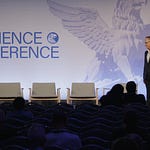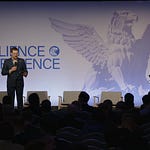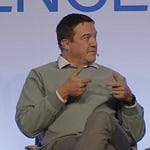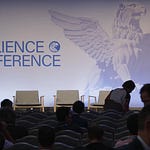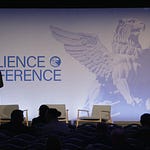Resilience hosted a fireside chat on hypersonic technology with Zach Shore, Chief Revenue Officer at Hermeus, interviewed by Leslie Hitchcock. The discussion addressed timelines, economics, and the cultural barriers that shape adoption inside the U.S. Department of Defense.
Hermeus is building reusable hypersonic aircraft for defense. The company’s mission is to build the world’s fastest aircraft using rapid, hardware-heavy iteration with modern computing and autonomy. Its Chimera engine is a turbine-based combined cycle, running as a jet at low speed, then routing flow to a ramjet at high speed. In short, they’re building reusable, multi-mission hypersonic UAVs for national security use, something that Shore believes is the key to next-generation long-range weapons.
Shore framed the strategic context: the great-power competition has returned, and distance drives risk. The central operational question is time to target, he said, and hypersonics are one answer.
“I mean, think one of the things we know right now is that the world is sort of in a geopolitical rebalancing,” he said. ”The world has shrunk, one of the big challenges is time to target. How quickly can you affect the enemy so that they have to respond to you?”
The United States, he said, is isolated by the Pacific and the Atlantic. Europe doesn’t have those benefits. His economic thesis is precise, and he believes that reuse bends the cost curve in long-range weapons and makes these weapons useful in long-range wars.
“You need to return the propulsion system,” Shore said, meaning that once a weapon drops its payload, it has to return to base. This means Hermeus is pursuing reusable hypersonic aircraft to capture those unit-cost gains, and because they are hypersonic, it takes less time to reach the target and less time to return.
Use cases are broad, including precious strikes, electronic attacks, and logistics runs. Shore set clear targets. The team is aiming for the supersonic flight in the first quarter of 2026 and hopes to reach Mach 3 in the first quarter of 2027. It wants to hit Mach 5 before the end of the decade.
The biggest issue is convincing those with cash to spend it on hypersonic.
“It’s really not an engineering challenge,” he said. “The biggest challenge that faces us is really systemic. I’d say it’s a large cultural barrier,” he said. “Let’s take a step back historically.”
He pointed out that the scientists who built the Manhattan Project and NASA were all young and very motivated. Currently, many Departments of Defence are sclerotic.
“You’ve seen this sort of development in the last ten years of people who’ve been working on these problems who don’t necessarily work in tech, they don’t work at SpaceX, they don’t work in Silicon Valley, they’ve only worked in the government,” he said. While that’s not bad, it does lead to slower innovation.
Shore also pointed to the Anduril model, which involved demonstrating in the field.
“PowerPoints don’t solve problems,” he said.
Capital can accelerate this path. Shore urged leaders to treat venture investment as additive. A contract dollar can unlock three to five private dollars, expanding the effective program pool in a flat top line. This dynamic explains why software and lower-cost hardware have led recent gains. Heavy systems remain harder to finance, but the impact is material if successful.
The session closed on first principles. Shore said that reuse changes unit economics and that demonstration is better than planning. Finally, he said to respect the record of past high-stakes programs that moved fast with clear authority. The world, he said, needs that kind of clarity when facing today’s threats.



